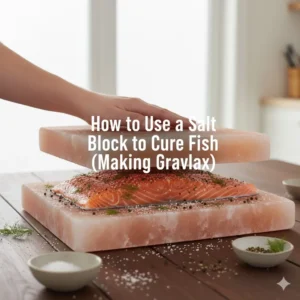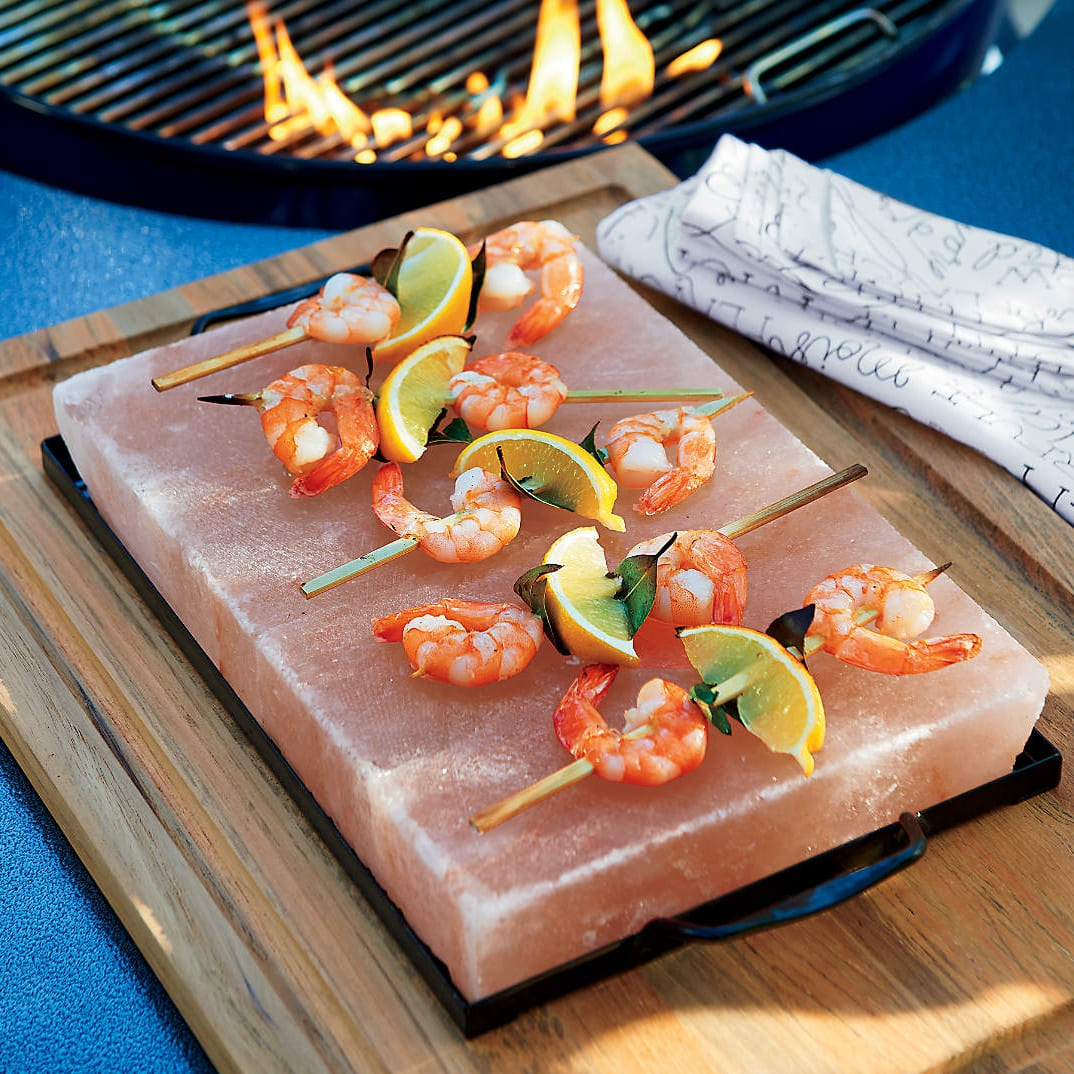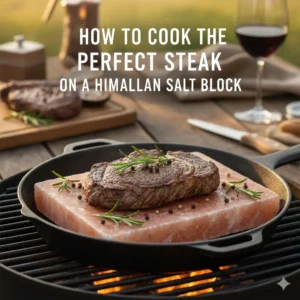Using a Himalayan salt block to cure salmon turns raw fish into refined, delicately seasoned gravlax. The block’s dense mineral composition draws moisture gradually, regulating salt transfer for a balanced cure and smooth texture. This method blends traditional preservation with modern precision, minimizing oversight while delivering consistent, professional-quality results. In this guide, you’ll learn how to prepare, cure, and serve salmon on a salt block for clean flavor and elegant presentation.

Prerequisites: Tools and Materials Needed
Before curing salmon on a Himalayan salt block, assemble the essential tools to ensure efficiency and precision. Each item contributes to balanced salinity, food safety, and the smooth, supple texture characteristic of premium gravlax. The list below outlines exactly what you’ll need and why each component matters.
| Item | Specifications | Purpose |
|---|---|---|
| Himalayan Salt Blocks | Two food-grade blocks, approximately 4 × 8 × 2 inches | Provides the curing surface and gentle, even pressure |
| Salmon Fillet | Fresh, skin-on fillet weighing 1–1.5 pounds | Primary ingredient for curing |
| Fresh Dill | Several sprigs, enough to cover the fillet | Adds aroma and infuses subtle herbal flavor |
| Plastic Wrap or Baking Pan | Used to contain the assembly during refrigeration | Prevents contamination and limits moisture loss |
| Sharp Knife | Optional—lightly score the skin if desired | Facilitates deeper salt penetration during curing |
Preparing these materials in advance ensures consistency throughout the process and helps achieve gravlax with a clean, balanced flavor and refined texture suited for any professional presentation.
Step-by-Step Guide to Curing Fish on a Himalayan Salt Block
Step 1: Chill the Salt Blocks Thoroughly
Place both Himalayan salt blocks in the refrigerator for several hours or overnight. Pre-chilling stabilizes the surface temperature, ensuring steady, controlled salinity transfer once the fish is added. A properly chilled block remains rigid throughout the process, preventing excess moisture release. This step is essential for both food safety and achieving a uniform cure without over-salted areas.
Step 2: Prepare the Salmon Fillet and Dill Layer
Set one chilled salt block on a baking tray to catch any runoff. Arrange a layer of fresh dill sprigs across its surface to act as a flavor base and protect the fillet. Place the skin-on salmon—approximately one to one and a half pounds—skin side down over the dill. For enhanced salt absorption, lightly score the skin with a sharp knife. Cover the exposed flesh with another dill layer to impart a clean, herbal fragrance during curing.

Step 3: Assemble and Wrap for Refrigeration
Position the second chilled salt block gently on top of the salmon. Its natural weight applies even pressure across the fillet. Secure the structure by wrapping it tightly in plastic wrap or placing it in a shallow, covered pan. Refrigerate the assembly so the block can draw moisture from the fish while infusing trace minerals. This stable, enclosed environment encourages an even cure and refined flavor throughout the fillet.
Step 4: Monitor and Adjust Curing Time
The optimal curing window ranges from roughly 36 hours to three days. Thinner wild salmon cures more quickly, while thicker or farmed fillets require additional time. Check periodically by gently pressing the flesh—it should feel firm with a dry surface yet remain supple inside. When this balance is reached, the gravlax has developed a clean, delicate flavor without overwhelming the fish’s natural richness.
Step 5: Finish and Serve the Gravlax
Once curing is complete, remove the setup from the refrigerator and unwrap carefully. Lift off the top block, discard the dill, and rinse the fillet briefly under cold water to remove surface brine. Pat dry with paper towels until the flesh feels smooth and firm. Slice the gravlax thinly with a long, sharp knife and serve on rye bread, crackers, or bagels with mustard sauce, cream cheese, or lemon wedges. The finished gravlax offers a clean, balanced flavor ideal for charcuterie boards or brunch presentations.
Elevate Your Business with Premium Himalayan Salt Blocks
Partner with Jilin Ever Creation for authentic, food-grade pink Himalayan salt sourced directly from the Khewra Salt Mine. Customize dimensions, shapes, and packaging to meet your culinary, retail, or hospitality requirements. Benefit from flexible order minimums, global delivery, and certified quality that elevate both flavor and presentation for your customers.

Understanding the Mineral Benefits of Himalayan Salt Blocks
Himalayan salt blocks contain trace minerals such as calcium, magnesium, and potassium that gently infuse into salmon or other fish during curing. This gradual mineral transfer refines flavor, softening the sharpness of ordinary salt into a rounded, savory depth. In gravlax preparation or similar charcuterie applications, the block’s dense mineral composition serves as both a natural flavor source and a functional curing surface.
These minerals affect texture as much as taste. As moisture slowly leaves the fish, the controlled salinity firms the flesh without toughening it, producing clean slices that hold their shape yet remain tender. This balanced result appeals to chefs who value precision and minimal intervention.
The block’s self-regulating release of salt adds further consistency. It draws moisture and seasons the fish at a steady rate, preventing over-curing and minimizing supervision. The outcome is a dependable, low-maintenance curing process that yields refined flavor and reliable texture every time.
Care and Maintenance of Himalayan Salt Blocks
Proper care allows Himalayan salt blocks to maintain their structure and mineral quality through multiple curing cycles. After curing salmon or other raw fish for gravlax, never immerse the blocks in water. Instead, wipe them gently with a damp cloth to remove surface residue, then let them air-dry completely before storing to prevent cracking or surface erosion.
Store salt blocks in a cool, dry location away from humidity or steam. A closed kitchen cabinet or open shelf distant from stovetops works well. Prolonged exposure to moisture can gradually dissolve the block and reduce its curing consistency.
Consistent maintenance preserves both appearance and functionality. By keeping the blocks clean, dry, and properly stored, you extend their lifespan and ensure steady, balanced salinity for every curing cycle.
Comparing Salt Block and Traditional Dry Cure Methods
Each technique for curing salmon produces distinctive results in texture and flavor. The salt block method delivers a gradual mineral infusion that naturally balances salinity, while the traditional dry cure applies seasoning directly for a bolder, more pronounced taste. Understanding these differences helps you select the most suitable approach for your preferred flavor intensity and level of process control.
| Feature | Salt Block Curing | Traditional Dry Cure |
|---|---|---|
| Salt Delivery | Slow, even salt release enriched with trace minerals | Direct application of a salt and sugar blend to the fish surface |
| Flavor Profile | Refined, mineral-driven flavor with a slightly firmer texture | More intense salinity and deeper spice penetration |
| Curing Setup | Fillet layered with dill and pressed between chilled salt blocks | Fillet coated in the curing mix, then tightly wrapped for refrigeration |
| Handling | Minimal direct salt contact; gentle, even pressure from the block | Manual rubbing and compression with added weights |
| Curing Time | Approximately 36 hours to three days, depending on fillet thickness | Comparable duration, though flavor and texture differ distinctly |
Both methods yield excellent gravlax. The salt block technique excels for its consistent mineral balance and refined mouthfeel, while the traditional dry cure remains the choice for those seeking bolder seasoning and a more tactile curing process.
Expert Tips and Common Mistakes in Salt Block Curing
Working with a Himalayan salt block refines curing from a basic preservation method into precise control over texture and salinity. To get consistent, high-quality results, it’s important to understand how temperature, wrapping, and timing influence the process. The table below outlines common errors that can affect gravlax quality and offers practical solutions for avoiding them.
| Common Mistake | How to Avoid or Correct |
|---|---|
| Using warm or room-temperature salt blocks | Chill the blocks thoroughly before use to maintain their structure and ensure controlled salt release during curing. |
| Wrapping loosely or allowing air exposure | Seal tightly with plastic wrap or place in a covered container to prevent drying or contamination. |
| Over-curing thick or oily fillets | Adjust curing time according to fish thickness and fat content; check texture periodically to avoid an excessively firm result. |
| Soaking salt blocks in water after use | Wipe the surface with a damp cloth, then air-dry completely to prevent cracking and preserve structural integrity. |
| Storing blocks in humid conditions | Keep blocks in a cool, dry area away from humidity to extend their lifespan and maintain consistent curing performance. |
Mastering salt block curing comes down to careful control of small variables. By keeping the blocks cold, sealing the wrap securely, and monitoring timing closely, you’ll achieve balanced gravlax that demonstrates both technical precision and respect for the quality of the fish.
Frequently Asked Questions About Using Himalayan Salt Blocks
How long does it take to cure salmon on a salt block?
Curing typically takes between 36 hours and three days, depending on the salmon’s thickness and fat content. Thinner wild fillets cure faster, while thicker or farmed cuts require additional time to firm up and absorb the gentle salinity. The gravlax is ready when the surface feels dry and the flesh is springy to the touch.
Do I still need to add salt when using Himalayan salt blocks?
No additional salt is required. The block naturally releases a controlled amount of salinity, ensuring the cure remains balanced. This gradual infusion prevents over-salting and allows the fish’s natural flavor to stand out.
Can I cure other foods, such as bacon, on a Himalayan salt block?
Yes, but the method works best for delicate proteins like fish or thinly sliced meats. Larger cuts such as bacon benefit more from a traditional dry cure, which ensures deeper and more uniform salt penetration over longer periods.
What is the proper way to clean the salt block after curing raw fish?
Wipe the surface with a damp cloth or soft sponge—never soak or submerge it in water. Let the block air-dry completely before storing it in a cool, dry place. Excess moisture can shorten its lifespan or cause cracking, so thorough drying is essential after every use.
Does salt block curing work faster than traditional methods?
Not necessarily—it’s slightly slower but far more controlled. The block releases salt gradually, promoting an even cure without harsh brining. The result is a smooth-textured gravlax with refined mineral depth rather than strong, direct saltiness.
Final Thoughts
Curing salmon on a Himalayan salt block offers a refined, low-effort way to achieve gravlax with balanced flavor and a clean, supple texture. The block’s measured salinity and trace minerals enhance the fish naturally, avoiding the harshness of traditional brining while preserving its richness.
Precision in preparation, timing, and block maintenance determines success. Adjust the curing duration based on fillet thickness and ensure the block is thoroughly dried after use to maintain consistent performance and longevity.
For seasoned cooks, this technique unites traditional gravlax craftsmanship with contemporary precision—turning a simple preservation method into a rewarding expression of culinary skill.






